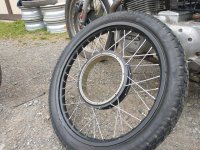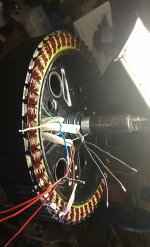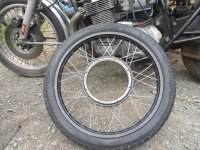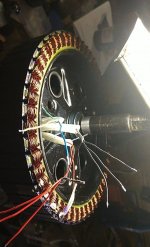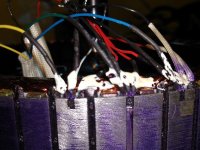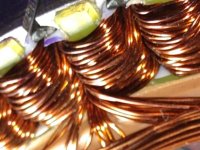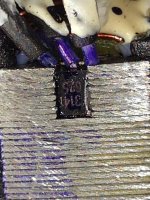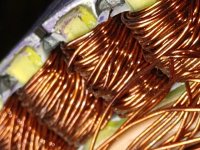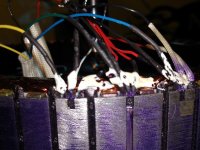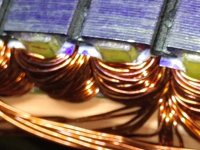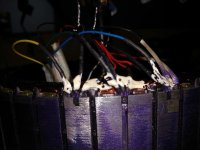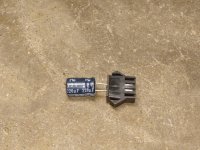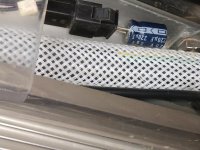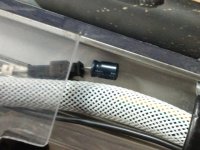DogDipstick
100 kW
I got a problem.. Been getting running resets while riding for the last 25-40 miles. Began slowly, and hall error ( 4.2) shows on the bike.
Kelly KEB 72330.. Just goes into error anymore in a few min.
Qs V1 35H 205 .. sometimes stutters, but usually just drops power on a roll...
Been hard on the motor, heat and power wise, with high watt high bursts from a 1000w design... but never ran over 3Kw contin..... Pics inside are just fine, no burning discolorations... definitely heated up a good bit though. Ran hot for what mods ad others here recommended... ( Rode hard enough to think to myself.. "Somethings gonna break... ") Jumps, burnouts, doughnuts, endos, banging the hub around on its dropouts. ... Could magnets be moving cause the errors? Something I didnt check...
CA3 with all the bells and whistles. All of them, I think. Alot at least. The 2 Aux, hall pickup speed sensor, TCDM, shunt, logger, dc/dc, the whole 9 yards. I hope ( think i) set it up correctly, it lasted 700 reliably smooth miles before trouble began.
Fixed the Hall sensors, with a new set bought from our fellow forum poster E. Lyen, even though they (OEM halls) were triggering on back-probe fine.. .. what appeared to be correctly, and both with the digital meter and a BLDC tester box. In sequence, all firing. ( ironically I cracked my Tq arm vertically in half almost... , but still held.. I should've taken a pic.. First removal of the rear wheel in 700 miles.. ) all welded up now... )..Both the new and the old acted the exact same way on the tester.
Bike lasted 2 miles, then the resets began again. Still fires all hall sensors in sequence, on the meter and the box. Can ride reliably for about one min. Then any hard bump, or 20-80A+ hit, of fast overrun, and the error pops. Even unloaded.
Even just sitting there powered, the error pops when the bike has not moved. Should Hall error pop when no movement is made? Does that mean its in the controller? I went over EVERY bit of wire and connection for shorts or damaged/compromised... twice or more times.
What do you guys think? Kelly, Qs, or the CA3 Krabappel? Even if it just sits there, not moving, I reliably get a Hall sensor error in ten min or so. The controller case is also kinda warm, but that may be normal. The controller was bought used, and worked great, but is old. Like probably 8-10 years old, bought off a forum member here.
Anybody have any Idea as to where igo next? F'in dogs all washed up here. Dont have alot of money.. but I have a 4115 Lyen controller here I could maybe use to rule out the Kelly.. but that is a big big chore.. complete teardown to fit the 4115 Lyen. Also have a new CA3. Getting my ( second ) set of Hall sensors in soon, and going to try to replace them again... IDK if I did something wrong the first time, but they all fire.
Thank you for anybody that can shed any whim of help here, I am exhausted in testing. i cannot find something wrong. I go over logs... no flukes, except a transient Speed spike to like 655mph every 30-40 logs.... Or the Ca Analogger forgets to record ( fake SD card? Card popped out from bumps? One or the other... ) got a new one now.....Yes this was also happening at the same time as the resets )) or something.. leaves a log out of sequence.. IDK what is happening. Maybe the CA is resetting? IDk. I got it for a tool to test for conditions, and it works good for the most part, I just get that speed spike to unrealistic speeds very now and again.
Tahnk you ANYBOOOOODY. Im at wits end here, gonna buy a new motor in about .... lets say soon. I dont want to. I want to learn what the problem is.
Options: New motor New controller New CA3.. Or fix what I got. I would rather fix what I got. I cant do everything at once, thats for sure, and I need the commuter. Hell, if someone want this motor for 100$, I would do it. Get a new one, with a few more ( hundred certainly) dollars , and rebuild the bike.
Kelly KEB 72330.. Just goes into error anymore in a few min.
Qs V1 35H 205 .. sometimes stutters, but usually just drops power on a roll...
Been hard on the motor, heat and power wise, with high watt high bursts from a 1000w design... but never ran over 3Kw contin..... Pics inside are just fine, no burning discolorations... definitely heated up a good bit though. Ran hot for what mods ad others here recommended... ( Rode hard enough to think to myself.. "Somethings gonna break... ") Jumps, burnouts, doughnuts, endos, banging the hub around on its dropouts. ... Could magnets be moving cause the errors? Something I didnt check...
CA3 with all the bells and whistles. All of them, I think. Alot at least. The 2 Aux, hall pickup speed sensor, TCDM, shunt, logger, dc/dc, the whole 9 yards. I hope ( think i) set it up correctly, it lasted 700 reliably smooth miles before trouble began.
Fixed the Hall sensors, with a new set bought from our fellow forum poster E. Lyen, even though they (OEM halls) were triggering on back-probe fine.. .. what appeared to be correctly, and both with the digital meter and a BLDC tester box. In sequence, all firing. ( ironically I cracked my Tq arm vertically in half almost... , but still held.. I should've taken a pic.. First removal of the rear wheel in 700 miles.. ) all welded up now... )..Both the new and the old acted the exact same way on the tester.
Bike lasted 2 miles, then the resets began again. Still fires all hall sensors in sequence, on the meter and the box. Can ride reliably for about one min. Then any hard bump, or 20-80A+ hit, of fast overrun, and the error pops. Even unloaded.
Even just sitting there powered, the error pops when the bike has not moved. Should Hall error pop when no movement is made? Does that mean its in the controller? I went over EVERY bit of wire and connection for shorts or damaged/compromised... twice or more times.
What do you guys think? Kelly, Qs, or the CA3 Krabappel? Even if it just sits there, not moving, I reliably get a Hall sensor error in ten min or so. The controller case is also kinda warm, but that may be normal. The controller was bought used, and worked great, but is old. Like probably 8-10 years old, bought off a forum member here.
Anybody have any Idea as to where igo next? F'in dogs all washed up here. Dont have alot of money.. but I have a 4115 Lyen controller here I could maybe use to rule out the Kelly.. but that is a big big chore.. complete teardown to fit the 4115 Lyen. Also have a new CA3. Getting my ( second ) set of Hall sensors in soon, and going to try to replace them again... IDK if I did something wrong the first time, but they all fire.
Thank you for anybody that can shed any whim of help here, I am exhausted in testing. i cannot find something wrong. I go over logs... no flukes, except a transient Speed spike to like 655mph every 30-40 logs.... Or the Ca Analogger forgets to record ( fake SD card? Card popped out from bumps? One or the other... ) got a new one now.....Yes this was also happening at the same time as the resets )) or something.. leaves a log out of sequence.. IDK what is happening. Maybe the CA is resetting? IDk. I got it for a tool to test for conditions, and it works good for the most part, I just get that speed spike to unrealistic speeds very now and again.
Tahnk you ANYBOOOOODY. Im at wits end here, gonna buy a new motor in about .... lets say soon. I dont want to. I want to learn what the problem is.
Options: New motor New controller New CA3.. Or fix what I got. I would rather fix what I got. I cant do everything at once, thats for sure, and I need the commuter. Hell, if someone want this motor for 100$, I would do it. Get a new one, with a few more ( hundred certainly) dollars , and rebuild the bike.



